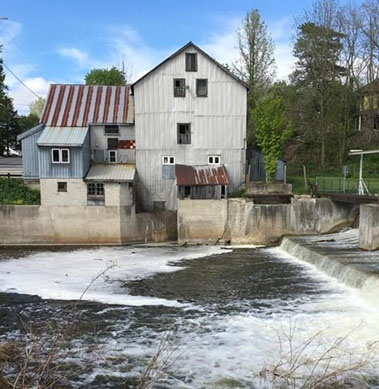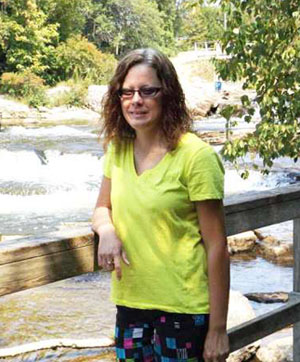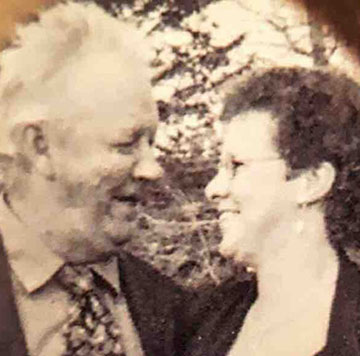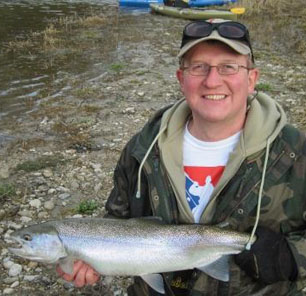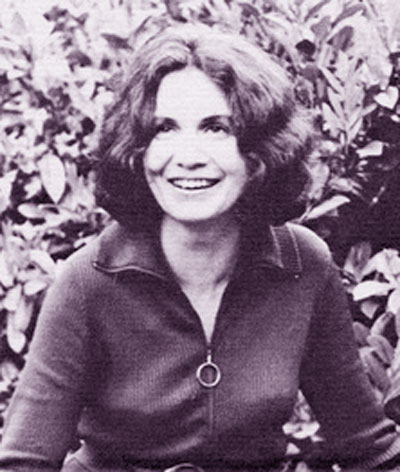Does murder in Alice Munro country say something larger on troubled times?
Jan 22nd, 2019 | By Dominic Berry | Category: Crime Stories
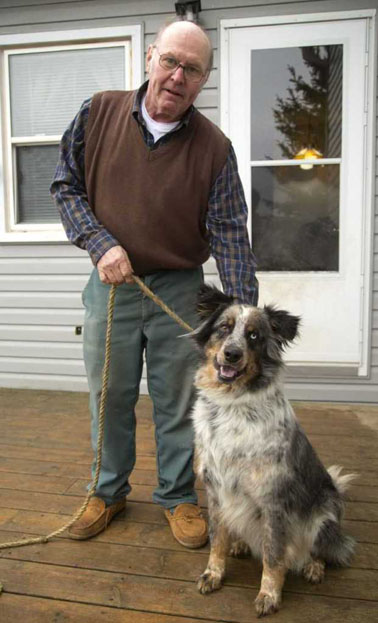
David Salter, 71, neighbour to the murdered Doug and Marian Fischer on C Line Road in Huron County, Ontario, and his dog, Donald Trump. Photo : Mike Hensen/The London Free Press.
A man’s gruesome rape and kidnapping of his ex-girlfriend, just after his murder of her parents, should make a gripping old-school crime drama in any context.
At the same time, I have been told that I haven’t personally contributed a crime story to this site for more than a decade (“Depression economics and crime : Marine murders in California, Toronto youth violence,” Nov 15th, 2008).
And the site itself hasn’t dabbled in the subject for not much less than a decade (“Murder on the Bruce Peninsula revisited .. again .. and again .. and again …,” Jun 4th, 2009).
There has been a much more recent editorial decision to reclassify a political piece as a crime story (“Has Donald Trump pushed us into a new age of political mendacity, like Orwell’s time between the two world wars?” Jun 20th, 2018).
More recently again I’ve been unusually intrigued by the strange story of the man who raped and murdered his ex-girlfriend and so forth — an old-school crime drama with a potential broader new twist. And even though it’s been a long time since we last got together, the counterweights editors have agreed to indulge my interest.
Why am I (or are we, the editors would say) suddenly returning to old-school crime, after so long away?
The case that intrigues me now involves the hometown of Southwestern Ontario’s Nobel Prize-winning short story writer, Alice Munro. It raises (almost political) issues that she has long explored but may be unusually relevant today — north of the North American Great Lakes and in other places elsewhere.
Possibly more to some exact point, when the regional mass media first began to explore the scene of the crimes in question here, on C Line Road near Bluevale, Ontario, they interviewed a rural neighbour, David Salter, 71, who “said a retired couple lived on the property in a new home they shared with their adult daughter.”
On March 29, 2018 Mr. Salter had been puzzled by some very early morning barking from “his dog, a two-year-old Australian shepherd mix he named Donald Trump.”
(And for a few further gruesome details on “1. Kevin Carter from Wingham murders ex-girlfriend’s parents then rapes her on crazy morning at 42371 C Line Road, near Bluevale, March 29, 2018,” and “2. Kevin Carter’s day in court and the ways in which the tragic story of Gail and Kevin and Marian and Doug does sound like something by Alice Munro,” click on “Read the rest of this page” and/or scroll below!)
1. Kevin Carter from Wingham murders ex-girlfriend’s parents then rapes her on crazy morning at 42371 C Line Road, near Bluevale, March 29, 2018
NEW ROMANCE AND NEW HOUSE
Gail Fischer and Kevin Carter at Niagara Falls, in happier times.Kevin Carter and Gail Fischer began seeing each other romantically in 2011, in the wake of earlier failed marriages on both sides. They had known each other for years.
He was a 50-year-old auto worker from Wingham, Ontario. She was a teaching assistant whose father Doug Fischer owned land on C Line Road near Bluevale, just southwest of Wingham along Huron County Road 86.
Gail’s father Doug and his wife Marian Fischer had been living in a trailer on the C Line Road property. As Gail and Kevin’s romantic relationship blossomed into something that seemed more durable, Gail proposed putting up a new prefab house at 42371 C Line Road. Her parents would live on a wheelchair-accessible first floor. She and Kevin would be on the second floor.
All happily agreed. To help secure a mortgage to pay for the prefab, Doug Fischer sold his C Line Road property to the three others for $1. The building went up, and, as planned, the two couples moved into their new house in February 2016.
TROUBLE IN DREAMLAND
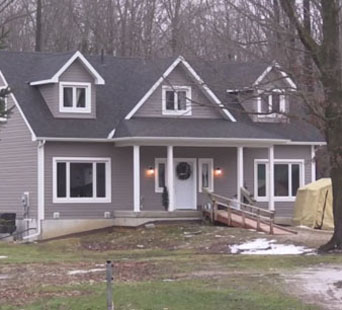
Rural pre-fab house on C Line Road near Bluevale and Wingham, Ontario that Kevin Carter once shared with his ex-girlfriend Gail Fischer and her parents Doug and Marian Fischer. Also scene of his murder of Doug and Marian and rape of Gail on March 29, 2018.
All four in the new household apparently got along at first. But this did not last.
Early in December 2017 an argument between Kevin Carter and Doug Fischer became so fierce that Gail Fischer called police. Things went from bad to worse. Kevin moved out of the C Line Road property two days before Christmas 2017.
Around the same time it became clear that Kevin also owed more than $45,000 in unpaid income taxes and credit card and line of credit debt. A “letter from creditors” arrived. They “were going ahead with a Sheriff’s sale of the C Line Road property” to cover Kevin Carter’s unpaid debts.
Gail and Marian “confronted Carter at a Wingham Tim Hortons [the great Canadian coffee shop chain] and offered to pay his credit card debt in exchange for his share of the house.” But Kevin just “laughed at them.”
THE GATHERING STORM
By early March 2018 the Fischers on C Line Road had put some belongings Kevin left behind in a shed outside. Kevin himself was intermittently “harassing Gail Fischer by following her and once left a box of rotting meat” in the driveway at 42371 C Line Road.
He had “written a letter to his lawyer,” saying he was willing to sell his share in the new house for $160,000. But in late March 2018 “he was told by his lawyer he was only entitled to one-third of the property and that amount wouldn’t cover his bank debt.”
Kevin had nonetheless continued to refuse the Fischers’ offer to pay his credit card debt in return for his share of 42371 C Line Road. He “told his lawyer if it wasn’t for him, they wouldn’t have qualified for a mortgage. He wanted the property sold.”
At the same time, Kevin had already written “a will in February 2018 and, in a letter to his ex-wife, he said, ‘Remember I am not a bad person, only a person who’s good choices went bad and bad choices went worse.’”
THE HORROR SHOW AT 42371 C LINE ROAD ON MARCH 29, 2018
At last, on the morning of Thursday, March 29, 2018 “Gail Fischer left the house to go to work.”
Kevin “was standing by her 2003 Jeep Liberty in the driveway. He attacked her and forced her to ground. He tightened the zip ties around her wrists behind her back, placed his hand over her mouth and told her had a .22 calibre gun.”
He also “said he was doing this ‘because she’d taken everything from him.’”
To make a long and all-too grisly story short, Kevin Carter then took Gail Fischer into the house he had left just before Christmas 2017.
Here he proceeded to shoot several times and ultimately kill both Doug and Marian Fischer, and then rape Gail — after forcing her, with the zip ties around her wrists now removed, “upstairs at gunpoint to their [former] bedroom ‘stating they were going to do this one more time’.”
At two different points as Kevin unleashed his horror show, however, Gail had managed to call 911 (first punching it in with her nose, while her hands were still tied).
In response, not long after she was “sexually assaulted” in the upstairs bedroom : “The police arrived and used a ram to get into the house. Carter walked downstairs ‘and told the officers that everything was okay.” He was arrested.”
For a fuller account of the gruesome details – and all the quoted passages above – see the able report by Jane Sims, published by the London Free Press on January 9, 2019, after details of the subsequent legal proceedings finally became public. (Non-local readers may also want to note that this London regional metropolis on this Thames River is the one in Southwestern Ontario, not the ancient Roman city in southern England.)
2. Kevin Carter’s day in court and the ways in which the story of Gail and Kevin and Marian and Doug does sound like something by Alice Munro
KEVIN PLEADS GUILTY
From the start of the legal proceedings that followed Kevin Carter’s arrest on March 29, 2018 he and his lawyer Robert Morris agreed to simply plead guilty to his appalling crimes.
When his day in court finally arrived Kevin read a short prepared statement : “I’m deeply sorry for the pain, grief and sorrow I caused … If I could turn the clock back, I would. . . . Doug and Marian were good people and I’m truly sorry for taking their lives.”
As also explained by Jane Sims at the London Free Press : “Defence lawyer Robert Morris produced 11 letters of reference from Carter’s friends, family, the superintendent of the Stratford jail [where Kevin was being held] and a pastor. One letter was from a co-worker whose life was saved by Carter when he used a defibrillator on him after he had a heart attack.”
Ms Sims notes as well : “No one could ever imagine that Carter, born and raised in Wingham, with no criminal record, a Wescast Industries employee for more than 30 years [Wescast is an autoparts plant], a father and grandfather, a cub scout leader, a volunteer firefighter who had a passion for fishing, would be capable of such depravity.”
THE CONCLUSIONS OF JUSTICE THOMAS
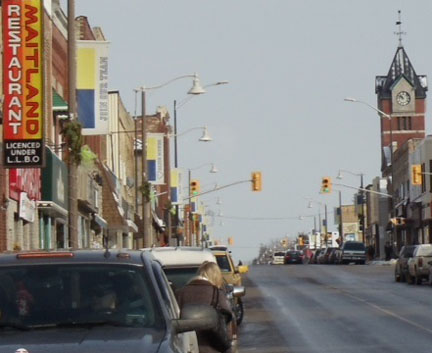
Main street of beautiful downtown Wingham, Ontario today, where both Kevin Carter and Alice Munro were born and raised, in somewhat different eras.
In the end Kevin Carter pled guilty to two charges of murder (Marian and Doug Fischer) and one of kidnapping (Gail Fischer). And the penalty handed down by Superior Court Justice Bruce Thomas was “three concurrent life sentences — including the maximum for kidnapping — and no chance of parole for 25 years.”
Justice Thomas “said he struggled with the letters of reference that painted a picture of ‘a kind and helpful, a loyal friend, a staunch supporter of the community.’”
But : “Frankly it’s as if they are discussing a different person … Nothing explains why Kevin Carter could have been so evil as to have destroyed this family with such violence … It was an act of greed, a final act of domination in a situation he found he could no longer control.”
Justice Thomas added : “Given the age of the offender, the guilty plea, the personal circumstances upon which I have commented and the real likelihood Kevin Carter will never be paroled, I believe concurrent sentences are fit and just in the circumstances.”
TURNING TO THE ALICE MUNRO WHO GREW UP IN WINGHAM LIKE KEVIN CARTER
(Editors’ Note : Some readers who have made it this far but are really getting tired — and/or others already well enough acquainted with Alice Munro — may want to skip this immediately following section, and just jump straight to the very last section below, on VERY LAST WORDS AT LAST … )
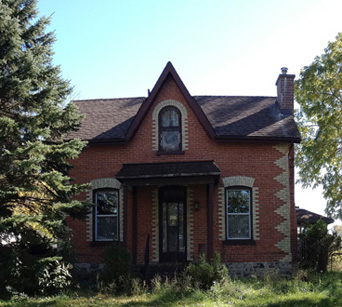
Alice Munro’s childhood home on her father’s fur farm, at the edge of Lowertown or Lower Wingham, subject to recurrent flooding.
Like Kevin Carter, the short-story writer Alice Munro, who won the 2013 Nobel Prize in Literature, is from the old town of Wingham in Southwestern Ontario.
Or at least she was born Alice Laidlaw in Wingham in 1931, and grew up on a fur farm just “west of Wingham along the Maitland River and adjacent to a separate, low-lying area which most years flooded, called Lower Wingham or ‘Lowertown.’”
Still more to the point, from “grade four in the fall of 1939” the future genius of the short-story “attended the Wingham schools … and that required a daily walk of just under three kilometers, traveling through Lower Town, across the Lower Town bridge into Wingham, and through the town to the school … This round trip continued until she graduated high school in 1949 ; these walks are a key to understanding Munro’s point-of-view, for in walking to school she ascended the social ladder and, returning, descended it through Lower Town, past its ‘“casual bootleggers and unsuccessful thieves.’”
I could go on far too much longer about Alice Munro — one of the few fiction writers who warmed my own middle age in a different part of the same most populous Canadian province, down in the self-invented “Greater” metropolis on the northwest shores of Lake Ontario.
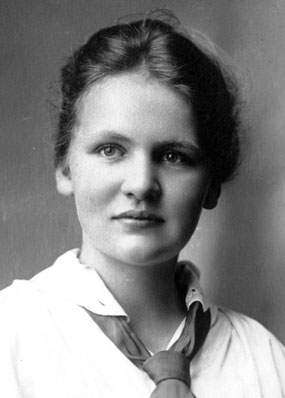
Alice Munro as a teenager living on the edge of Wingham — an experience she would write about in Lives of Girls and Women.
I’ll try hard to just make a few further quick notes :
* The passages I’ve just quoted here are from what strikes me as a very good short biographical introduction to Alice Munro and her writing by Robert Thacker, on The Nobel Prize website.
* Dennis Duffy and Daniel Baird on Alice Munro, on the Canadian Encyclopedia site, is (I think) shorter and possibly more digestible to some tastes.
* Lisa Allardice’s 2006 Alice Munro interview in The Guardian, direct from “the small town of Goderich, near Lake Huron where she has lived nearly all her life” is interesting (and sometimes amusing) from several angles. For my purposes here note esp, eg : “the landscape … whose inhabitants she has depicted with … ‘almost pathological empathy’.”
* Despite Ms Allardice’s “nearly all her life,” from her high school graduation in 1949 to the middle of the 1970s the Alice Laidlaw who became Alice Munro late in December 1951 lived away from the Huron County landscape in which she had grown up — at least to the end of high school. Most of that quite long time, in her still formative 20s and 30s, she lived in Vancouver and then Victoria far away in beautiful BC, on Canada’s Pacific Coast.
* Ms Munro nonetheless moved back to Huron County in the summer of 1975. This time she lived in the old town of Clinton, somewhat southwest of Wingham along County Road 4 (aka London Road). It was the hometown of her second husband — a “physical geographer” who had left “a career with the Canadian government … to look after his elderly mother in the house he grew up in.” (Though as noted in the Canadian Encyclopedia article : “Munro’s second husband died in April of 2013 and she divides her time between Clinton, Ontario and [a continuing bow of sorts to her long earlier time in Vancouver and Victoria] Comox, British Columbia.”)
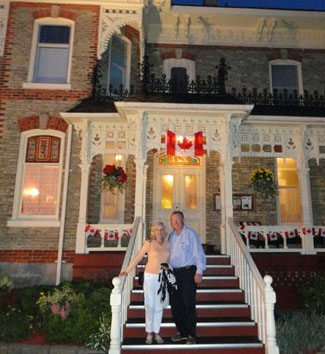
Bailey’s Fine Dining in Goderich, in Huron County, Ontario, where The Guardian writer from England Lisa Allardice met Alice Munro in 2006, has since been destroyed in a tornado. But it’s said that its place as number one restaurant in town has been taken over by Thyme on 21, pictured here decked out for Canada Day or some related occasion.
* As Robert Thacker also explains, “While not exclusively so, Munro’s stories are mostly set in and drawn from Huron County, Ontario, elaborating its people, its changing culture, its way of life. As Munro once told an interviewer, ‘I am intoxicated by this particular landscape, at home with the brick houses, the falling down barns, the trailer parks, burdensome old churches … everything here is touchable and mysterious.’”
* From one angle, Huron County is part of the wider region of Southwestern Ontario. This is the part of the central Canadian anglophone province traditionally viewed as most similar to the adjacent US Midwest — as in the historian Fred Landon’s 1940s book on Western Ontario and the American Frontier. The wider region has its own version of what remains today of the old North American family farm democracy of the late 19th and earlier 20th centuries — with all its good and bad, progressive and conservative, inspiring and appalling, forward-looking and stuck-in-the-mud-of-the-past-forever sides. It has all been slyly written about from another informed perspective in John Kenneth Galbraith’s memoir of his Elgin County, Ontario childhood in The Scotch (anchored on the shores of Lake Erie instead of Lake Huron, further south).
 * From more or less the opposite angle, I have visited the old town of Wingham in Huron County myself, in search of some more direct connection to the world of Alice Munro. I can testify that it is a typical enough old small town in rural and small-town Southern (and Southwestern) Ontario. But it is somewhat uniquely gifted for a place of its size as well (just under 3,000 people in the 2016 census). It has had, eg, a radio station since the 1920s — nowadays CKNX “which broadcasts at 920 AM” with “a classic country music & news format.” Along with a hospital and a high school, it also has the auto-parts producer Wescast Industries, where Kevin Carter worked, and “Royal Homes … a manufacturer of pre-fabricated homes.” When I visited the place a while back now it was still unsure how it felt about the Alice Munro who nowadays lives in Clinton down the London Road. But things have changed as she has become more famous. The old Wingham town mothers and fathers finally established a Literary Garden in her honour in 2002.
* From more or less the opposite angle, I have visited the old town of Wingham in Huron County myself, in search of some more direct connection to the world of Alice Munro. I can testify that it is a typical enough old small town in rural and small-town Southern (and Southwestern) Ontario. But it is somewhat uniquely gifted for a place of its size as well (just under 3,000 people in the 2016 census). It has had, eg, a radio station since the 1920s — nowadays CKNX “which broadcasts at 920 AM” with “a classic country music & news format.” Along with a hospital and a high school, it also has the auto-parts producer Wescast Industries, where Kevin Carter worked, and “Royal Homes … a manufacturer of pre-fabricated homes.” When I visited the place a while back now it was still unsure how it felt about the Alice Munro who nowadays lives in Clinton down the London Road. But things have changed as she has become more famous. The old Wingham town mothers and fathers finally established a Literary Garden in her honour in 2002.
VERY LAST WORDS AT LAST …
The crux of what I’m trying to get at in comparing Kevin Carter’s murder of Doug and Marian Fischer and rape of Gail Fischer in Huron County, Ontario on March 29, 2018 to an Alice Munro story is well enough summarized, I think, in an October 15, 2013 piece by dougcube on his Cubic Muse website, called “The Ghosts of Alice Munro.”
Mr. Cube approaches his ghosts “by looking at two stories about neighbors, ‘The Shining Houses” (from Dance of the Happy Shades, 1968) and ‘Fits” (from The Progress of Love, 1985). One is the story of the cruelty of supposedly good people; the other traces a town’s reaction to the murder suicide of an elderly couple.” In both stories : “Events trigger reactions and it is the contemplation of these reactions that awaken a new sense of understanding in the central characters.”
Mr. Cube is indebted to “my sister Janet Pope for suggesting the topic of this post and for lending me copies of the two stories by Alice Munro. Along with the books, Janet wrote me the following note to add to this blog.” Ms Pope’s note begins with “Alice Munro takes ordinary people and starts digging.” And it ends, rather brilliantly I think, with : “She makes us see that people are endlessly complex, ‘moving out of their prisons, showing powers we never dream they have … we, as ‘ordinary people,’ learn to recognize and respect our subterranean depths.”
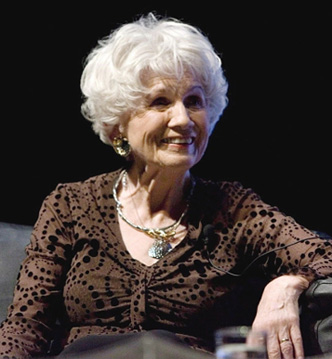
Alice Munro at the 2009 International Festival of Authors in Toronto. CHRIS YOUNG / THE CANADIAN PRESS.
All this it seems to me does shed some serious light on the conclusion of Justice Thomas in the Carter case : “Nothing explains why Kevin Carter could have been so evil as to have destroyed this family with such violence .” Or on Jane Sims’s London Free Press conclusion that : “No one could ever imagine that Carter, born and raised in Wingham, with no criminal record, a Wescast Industries employee for more than 30 years, a father and grandfather, a cub scout leader, a volunteer firefighter who had a passion for fishing, would be capable of such depravity.”
All this implies, I am no doubt more vaguely suggesting as well, some parallel power in Alice Munro’s stories to help us deal with the current frequently alarming “subterranean depths” of our democratic politics in so many parts of the world today.
Down on the ground of Ms Munro’s Huron County, this takes us back to the rural neighbour of the Fischer property on C Line Road, David Salter, 71, who has named his two-year-old Australian shepherd dog Donald Trump. And it is true enough that in the recent June 7, 2018 Ontario provincial election the Conservative candidate Lisa Thompson won the electoral district of Huron-Bruce (which includes all of Huron County) with 52% of the vote. The current provincial Conservative leader (and Premier of Ontario) Doug Ford is at least a somewhat secret half or even three-quarters admirer of President Trump in the USA. And Lisa Thompson won Huron Bruce for the Conservatives in the 2014 and 2011 Ontario elections too.

If you are starting to think that winter in Southern Ontario is getting just a little too wintry this year, consider this early January 2019 image of Northern Cape Breton in Nova Scotia, where “the snow banks on the side of the road are 13 or 14 feet maybe more in places.” Tks to Carter Fraser SLEDDERZ.
On the other hand, none of Huron County, Huron-Bruce, or Southwestern Ontario has a past of resolute Conservatism or conservatism, to say nothing of extreme right-wing political thought. In the Ontario elections of 2003 and 2007 Carol Mitchell won Huron Bruce for the Ontario Liberals. The riding was Liberal consistently from 1962 to 1990. And in the unusual 1990 election it sent a (more clearly “socialist”) New Democrat to the legislature at Queen’s Park in Toronto. Southwestern Ontario at large was once a bulwark of an earlier Ontario Liberal party, ancient voice of the old North American family farm democracy north of the Great Lakes.
My own ultimate political conclusion is that the progressive cause in Canada’s most populous province today could profit from some extended pondering of the “subterranean depths” in Ontario society, as made more intelligible in the short stories of Alice Munro.
